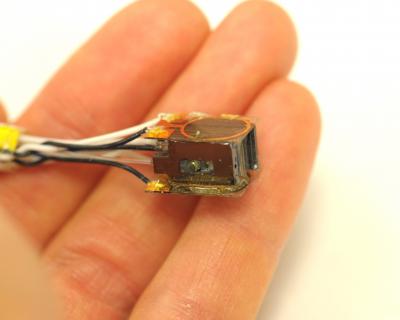The National Institute of Standards and Technology (NIST) has developed an atom-based miniature magnetic sensor for measuring magnetic activity in the human brain. The sensor holds potential for studying neurological diseases and mental processes.
 NIST's atom-based magnetic sensor, about the size of a sugar cube, can measure human brain activity. Inside the sensor head is a container of 100 billion rubidium atoms (not seen), packaged with micro-optics (a prism and a lens are visible in the center cutout). The light from a low-power infrared laser interacts with the atoms and is transmitted through the grey fiber-optic cable to register the magnetic field strength. The black and white wires are electrical connections. Credit: Knappe/NIST
NIST's atom-based magnetic sensor, about the size of a sugar cube, can measure human brain activity. Inside the sensor head is a container of 100 billion rubidium atoms (not seen), packaged with micro-optics (a prism and a lens are visible in the center cutout). The light from a low-power infrared laser interacts with the atoms and is transmitted through the grey fiber-optic cable to register the magnetic field strength. The black and white wires are electrical connections. Credit: Knappe/NIST
The mini sensor could be used in magnetoencephalography (MEG) for performing various activities including, mapping brain activity before tumor removal surgery, conducting research on cognitive and perceptual processes, and checking visual perception in newborn children.
Eye lid movements are associated with alpha waves that occur in the brain. The mini sensor was used to measure these waves. A superconducting quantum interference device (SQUID) was used to measure the signals and the measurements of the mini sensor were compared. The NIST mini-sensor was slightly less sensitive, but it has advantages in terms of cost and size.
SQUIDs function well at -269°C and they have to be mounted in heavy flasks with cryogenic coolants. MEGs depend on arrays of SQUIDs for their functioning. The NIST sensor can function at room temperature and has the dimensions of a sugar cube. It could be used in MEG helmets. While customary atomic magnetometers are large and hard to make, the NIST sensors could be mass produced at a lower cost.
The NIST sensor contains a low-power infrared laser, about 100 billion rubidium atoms in a gas and fiber optics. The light absorption by the atoms is proportional to the increase in magnetic field. In 2010, the sensor had been used for measuring heart activity. The scientists have made modifications to the heaters and the optical fiber to increase the clarity of the signal.
The NIST sensor was tested in brain experiments at the Physikalisch Technische Bundesanstalt in Germany, where it measured one picotesla magnetic signals. NIST scientists are also developing a multi-sensor magnetic imaging system. An inexpensive sensor system can increase the feasibility of hospitals to conduct tests for traumatic brain injuries.